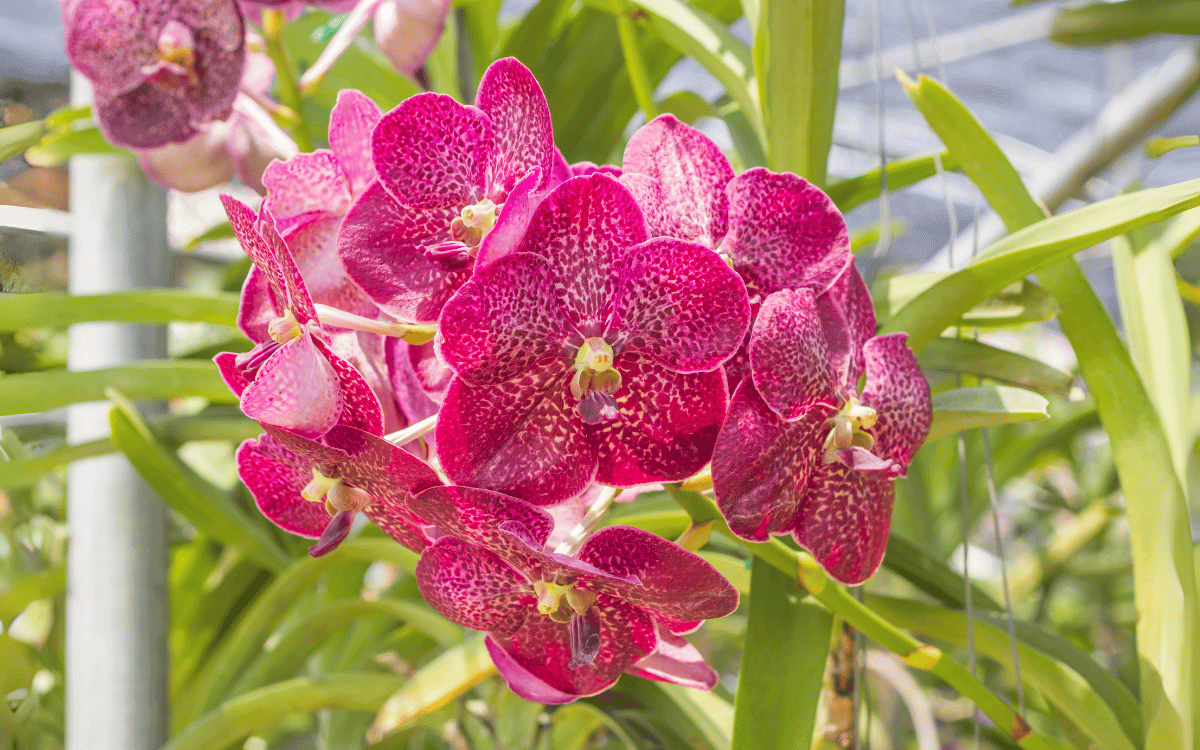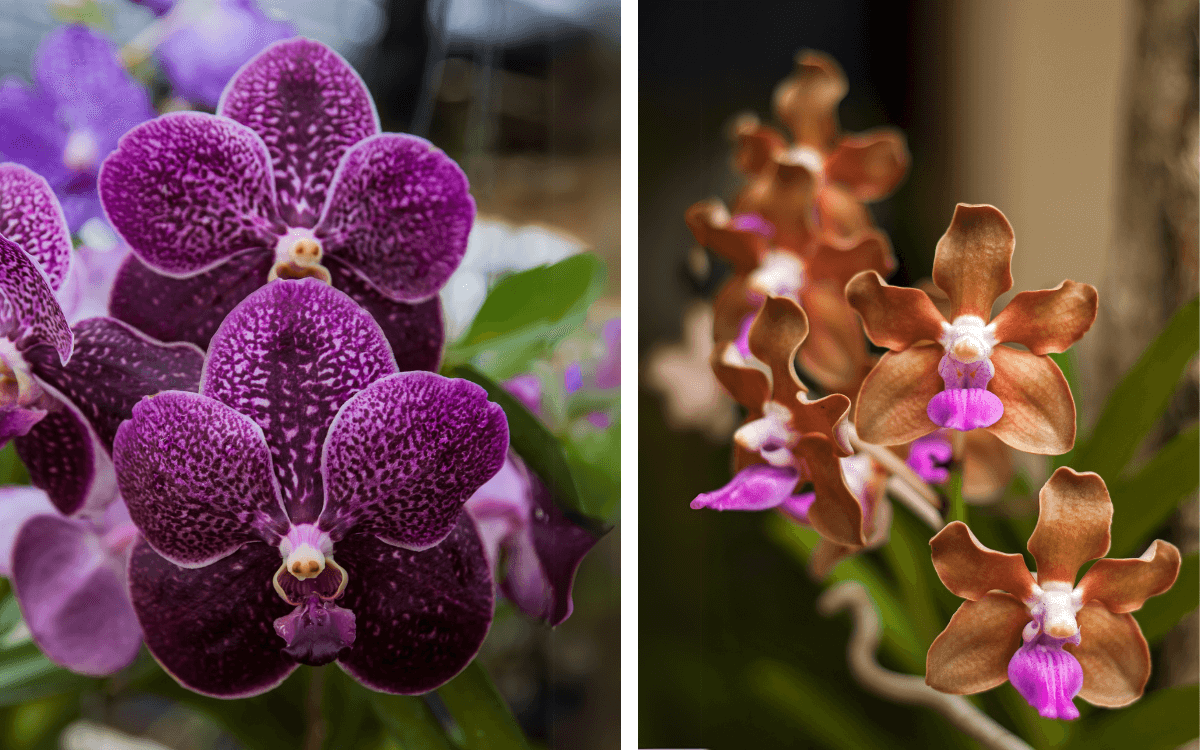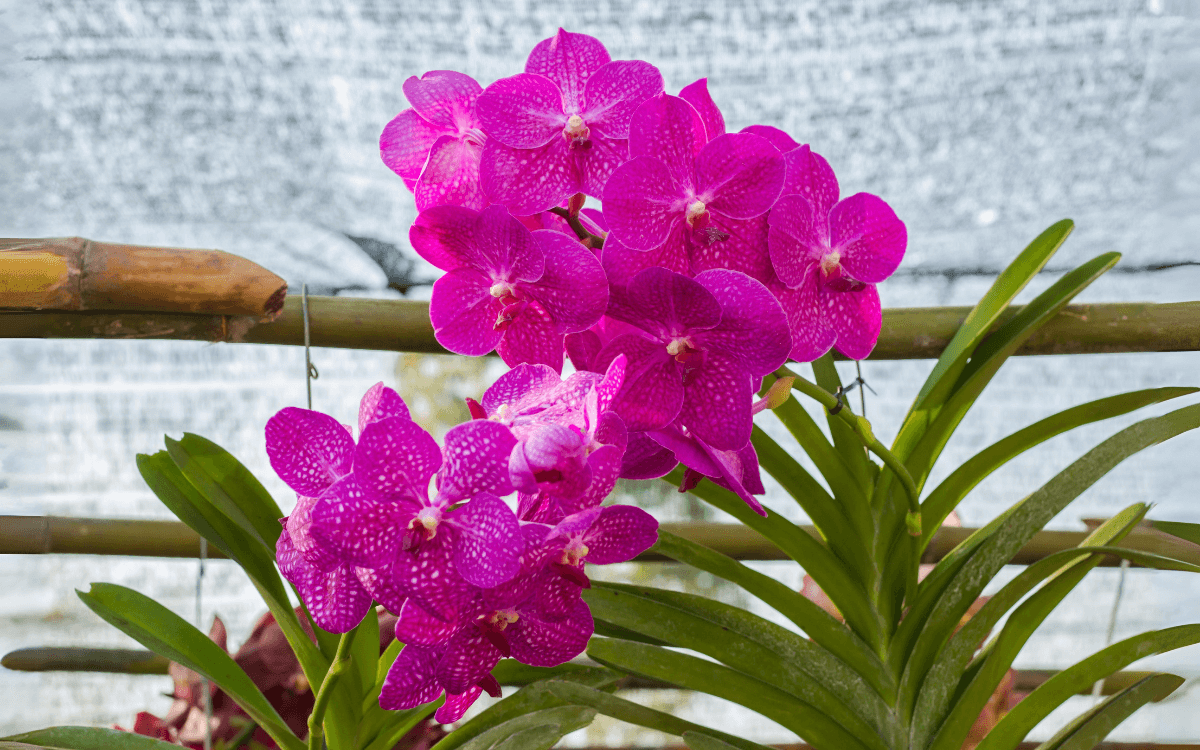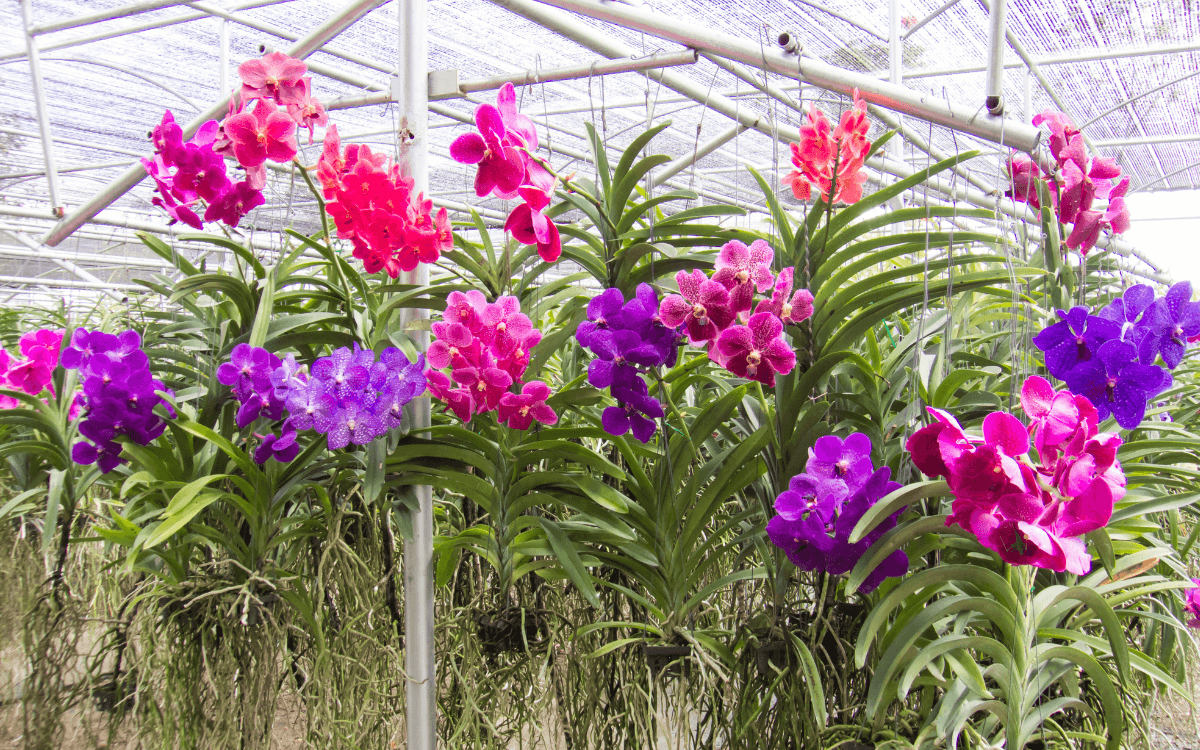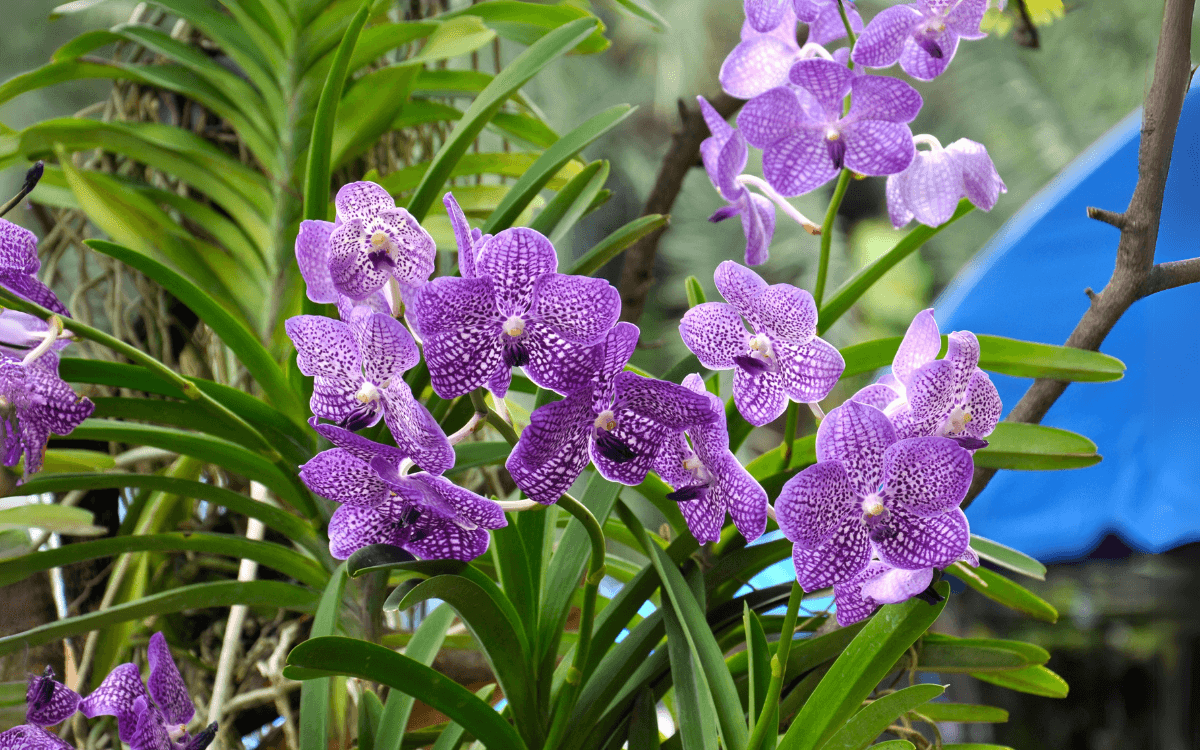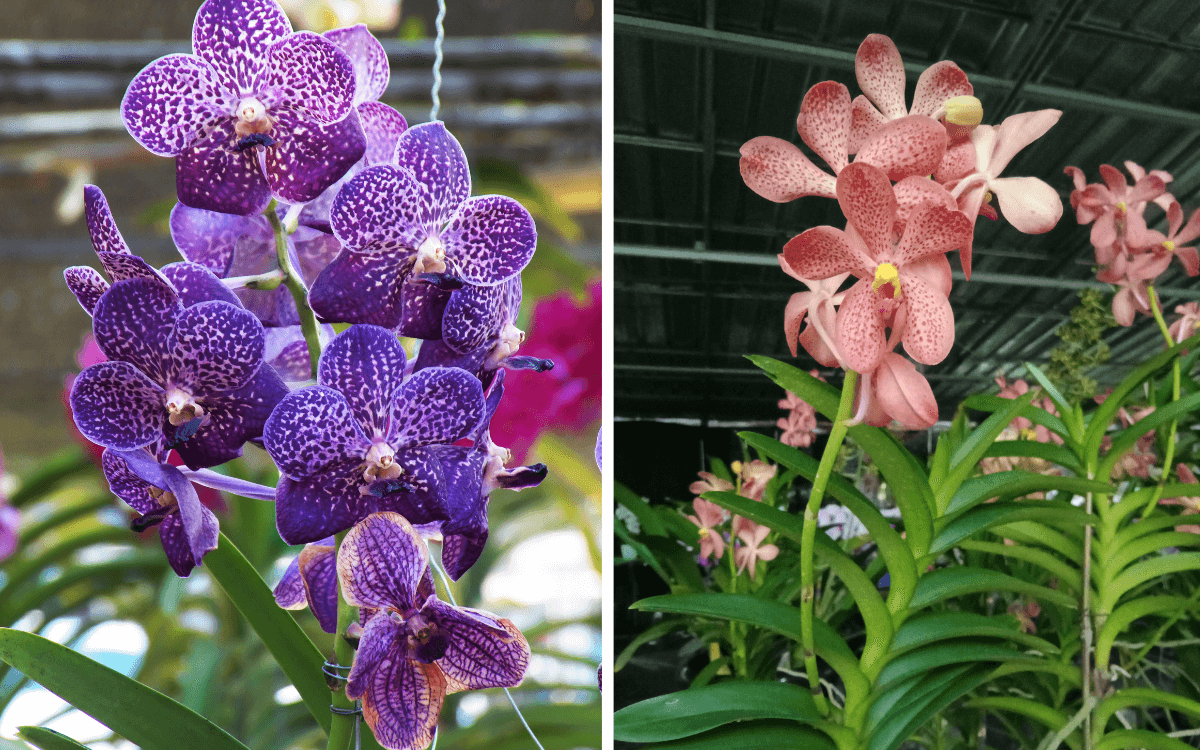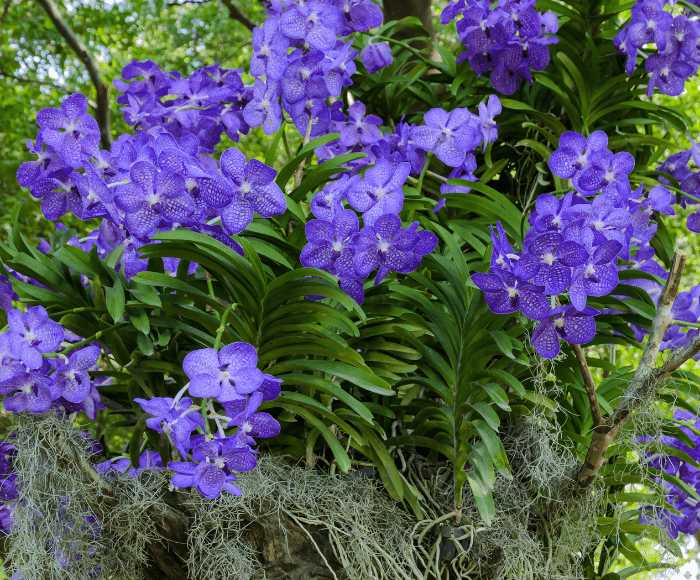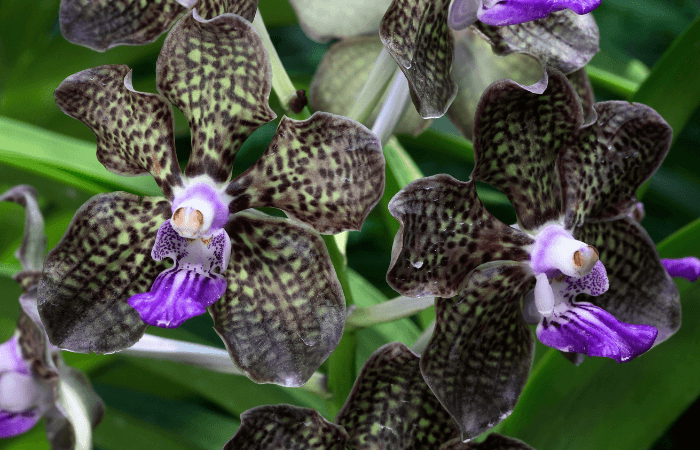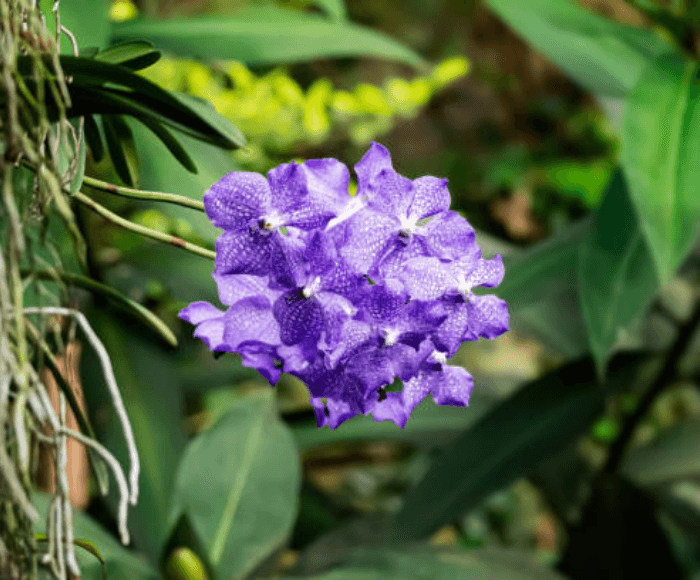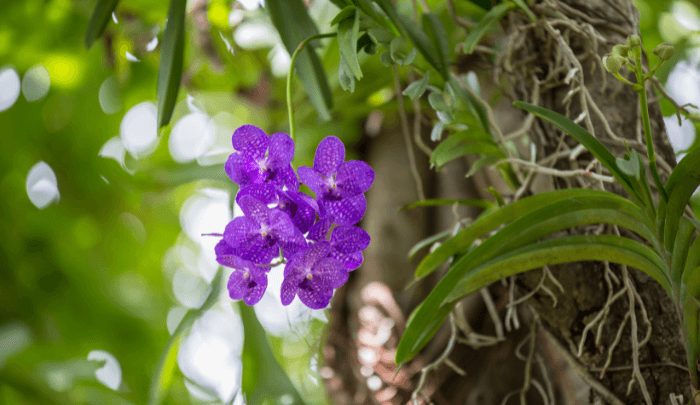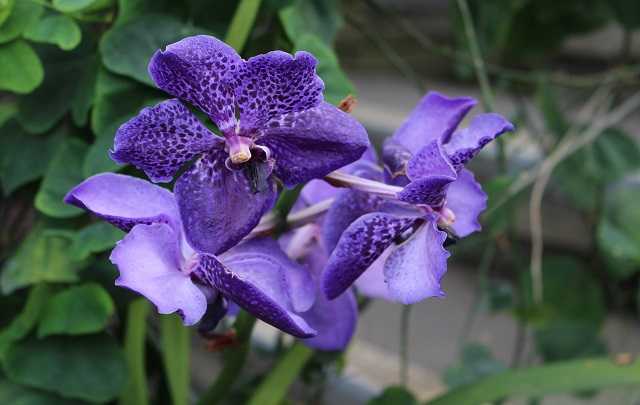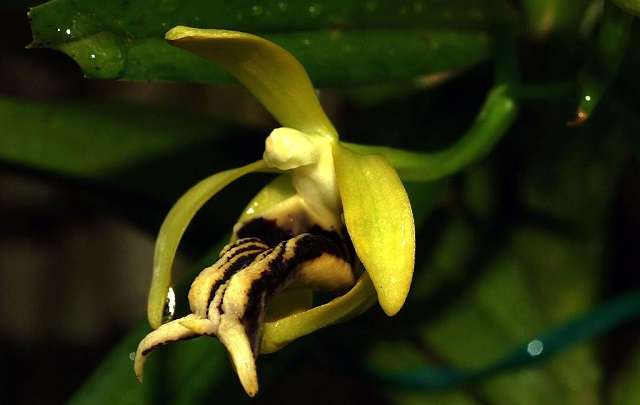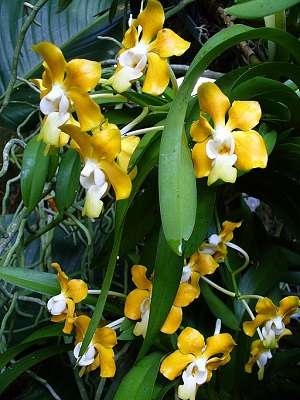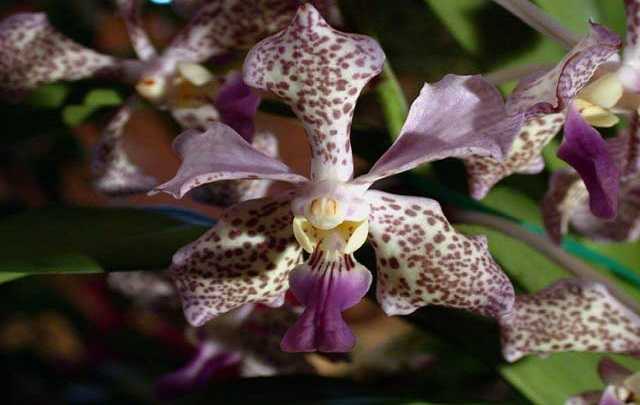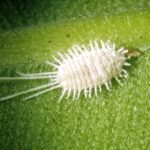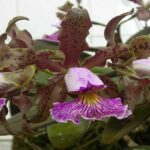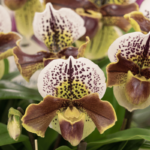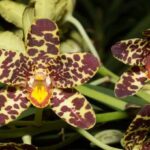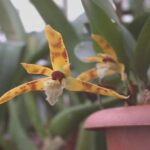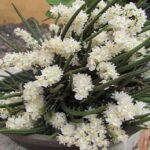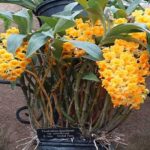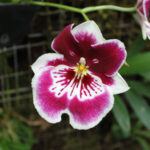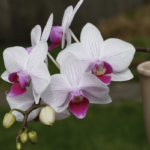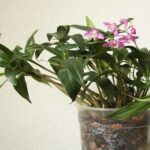With beautiful flowers up to 15 centimeters (5.9 inches) in diameter, Vanda orchids have won the hearts of countless growers around the world.
Native to the forests of Asia, these orchids like to live hanging and can reach up to 2 meters (6.6 feet) in height. Therefore, if you intend to cultivate a Vandacea, reserve a good space in your home or garden.
In this article, you will learn about the characteristics and curiosities of this plant, as well as the care needed to keep your vanda healthy and ready to bloom every year, so, keep reading and also access our free guide below.
Learn How to Achieve Super Blooms on Your Orchids
🛑 If you love orchids and you're tired of not being able to make them bloom...
Then, know that thousands of beginner growers are achieving beautiful flowers on their orchids by following this method.
Click the button below to have beautiful orchids with show-worthy flowers every year. ⤵
Characteristics and Curiosities about the Vanda Orchid
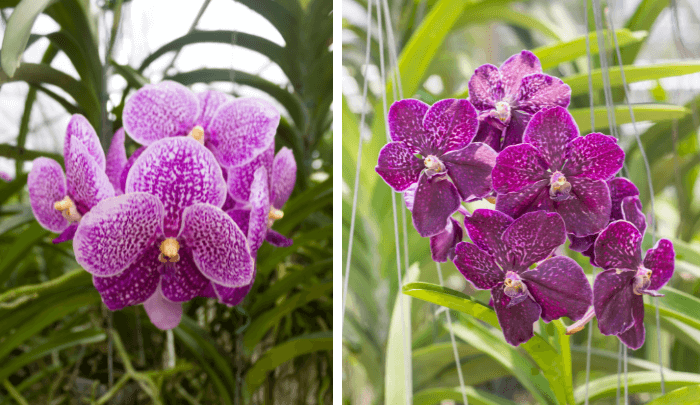
Originating from tropical regions like the Philippines, Thailand, and India, Vandas are highly valued for their beauty and adaptability.
Their leaves are long and narrow, they have a thick and fleshy texture, adapted to retain moisture.
The floral buds emerge directly from the stalk, between the bases of the leaves, producing striking flower spikes that can bloom at any time of the year.
Like Phalaenopsis and some Cattleyas, Vanda can bloom several times a year.
The flowers of this plant are known for their durability and some emit a delicate fragrance. The plant is capable of producing multiple flowers on each flower spike, with each flower lasting several weeks.
Below are some curiosities about the flowering of Vandas:
- Duration of flowers: Their blooms can last from 30 to 60 days.
- Diversity of colors: you can find Vandas with white, yellow, brown, wine, scarlet, orange, pink, and even blue flowers.
- Number of flower spikes: It can have up to 3 flower spikes.
- Number of flowers: produces 10 to 20 flowers and its flowers, after opening, continue to grow. To notice this, just see that the old flowers are slightly larger than the new ones.
- Evolution over time: in addition to its size, the number of flowers that the Vanda orchid gifts us increases with its age. The first blooms will have a smaller number of flowers, about 5 to 9, but over the years this number increases.
- Variety of flowers: Some species have flowers smaller than 1 cm, while others, the flowers are over 14 cm. For example, the flowers of Vanda tricolor are about 7.5 centimeters (2.95 inches).
In Thailand, this orchid is one of the country’s biggest export products.
How to Care for the Vanda Orchid
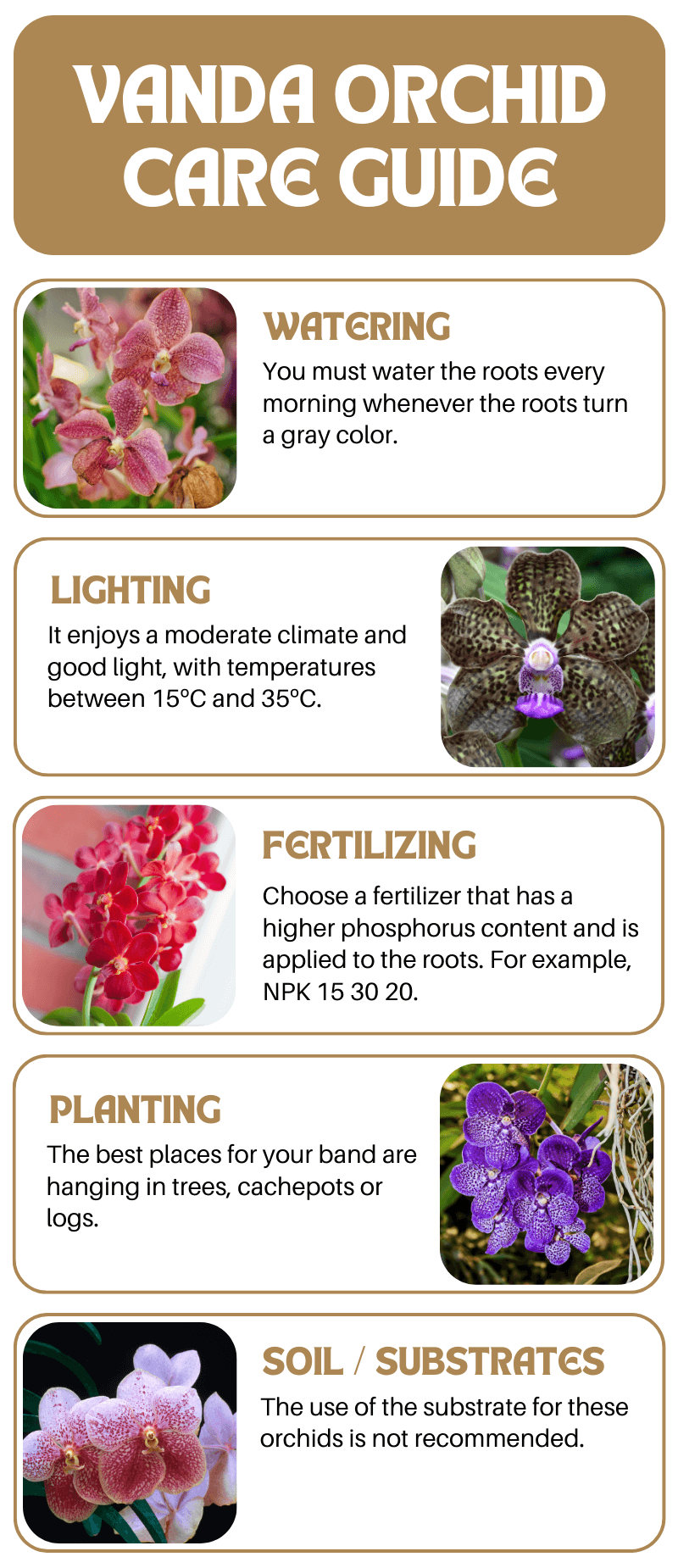
To care for the Vanda orchid, follow the steps below:
- Water when the root is grayed;
- Keep it at moderate temperatures, not too cold, nor too hot;
- Fertilize about every 7 days;
- Plant it on trees or let it hang;
- Do not use substrates;
- Do not spray water on the flower buds;
- Avoid replanting.
Below is a detailed explanation of these care steps:
How to Water
Unlike many other plants, Vandas have aerial roots that play a crucial role in absorbing moisture from the air.
These roots need constant hydration to stay healthy.
Therefore, to water your Vanda that is planted without substrates, you should water it by the roots in the morning whenever the roots turn gray.
For this, use a sprayer or a hose and water until the roots turn green.
Now, to water your Vanda planted with substrates, water abundantly after the substrate has dried.
Watering needs vary depending on climate conditions. On hot and dry days, Vandas may need more frequent watering and spraying, while on cold or rainy days, the amount of water should be reduced.
Humidity Care
Vandas like high humidity, with the recommended level being between 70% to 80%.
In addition, they give us some signs when they are receiving too much or too little moisture.
- If they have short roots and are well-developed, they are at the appropriate humidity level.
- Very long or excessive roots, are with low moisture, as they use this large amount of roots to seek moisture. Besides these signs, they will also start to lose the leaves near the roots.
- Roots or other parts of the plant rotting (black rot) occur when you have overly watered and provided too much moisture to your vanda.
Below are some tips to help you increase the humidity in your environment if you live in very dry places.
- Daily Spraying: spraying water on the leaves and exposed roots daily is an effective way to maintain moisture. This practice helps prevent orchid leaves from dehydrating and wilting, especially in indoor environments where the air can become very dry.
- Use of Humidifiers: in particularly dry environments or during winter, when heaters can reduce the air’s humidity, an air humidifier may be necessary to maintain the optimal humidity level.
While humidity is crucial, it is also important to ensure good ventilation to prevent excessive moisture buildup in the roots and substrate.
Vandas are sensitive to water stagnation, so even in a humid environment, adequate air circulation is essential to keep the roots healthy and prevent diseases.
Lighting and Temperature
The Vanda orchid thrives in well-lit environments with indirect sunlight.
Direct and prolonged exposure to the sun can be harmful, causing burns on the leaves. To prevent this, the plant should be positioned so that it receives filtered light through curtains or shaded by other plants.
Vanda orchids prefer a warm and stable climate.
During the day, temperatures between 20°C (68°F) and 36°C (96.8°F) are ideal, while at night, a slight drop to ranges between 15-21°C (59-69.8°F) benefits the plant, promoting a healthy cycle of growth and rest.
It is crucial to protect the Vanda from cold drafts and extreme temperature fluctuations, as this can stress the plant, leading to poor growth and lack of flowers.
In colder regions or with harsh winters, the Vanda may need additional protection from the cold.
Fertilization
The best fertilizer for Vanda Orchids is one with a higher phosphorus content and applied to the roots, for example, NPK 15-30-20.
Fertilization should be done weekly, especially during periods of active growth of the plant.
The fertilizer should be diluted in water, at the recommended proportion by the packaging, and applied directly to the plant, avoiding contact with the flowers. Application on the flowers can affect the flowering time and the health of the flowers.
Applying too much fertilizer can be as harmful as insufficient nutrition. Follow the dilution and application instructions carefully to avoid nutrient overload, which can lead to salt buildup in the substrate and potential toxicity.
During periods of less activity, such as in winter, it may be beneficial to reduce the frequency of fertilization to avoid nutritional stress and allow the plant to rest adequately.
When fertilizing, choose to fertilize when the sun is weakest, either early in the morning or late in the afternoon.
Where to Place and How to Plant
Vandas are epiphytic orchids, which means in nature they live hanging from trees, so when cultivating them, the ideal is to try to simulate their natural environment.
Below are some places where you can put your Vanda orchid:
- Trees
- Trunks
- Wooden boards;
- Walls;
- Hanging baskets;
- Wire supports or trellises;
- Cachepots.
It is important to provide space for the roots of this plant to grow freely, moreover, remember that Vanda orchids cannot be planted on the ground.
To help you learn how to plant your Vanda in the above places, below I have separated some videos that will help you:
Late spring or early summer are the most recommended times to move your Vanda, taking advantage of more favorable temperature and humidity conditions for the plant’s recovery and growth.
Do You Want to Learn How To Keep Your Orchids Healthy And Ready to Bloom Every Year?
So, I prepared a complete guide, step by step and illustrated, that will show you:
• The secrets to getting beautiful flowers every year
• How to fight and identify pests and diseases on your orchids
• THE MAGIC SUBSTANCE for orchids and how to use it
• And much, much more.
The great news is that the manual is now available at a super discount!!
But beware, it's only for the first buyers.
Click on MORE INFORMATION below and discover the secrets to show-worthy flowers. 👇
Should I Use Substrates?
The Vanda orchid can be cultivated both in substrate and with bare roots, being the ideal to cultivate it without the use of substrates.
For those Vandas cultivated in pots, it is crucial to use substrates that provide excellent drainage and air circulation.
Repot
It is not necessary to repot your Vanda orchid as long as it has been hung or fixed in place.
If you do repot, a common question is whether you can cut the roots of the Vanda.
Know that you should only cut the dead roots of your Vanda, these types of roots are dry and have a more grayish tone. While the healthy roots, which should not be cut, are greener.
Below is a video explaining how to repot orchids.
During the replanting process, you can perform the multiplication of your Vanda.
In this case, you will divide your Vanda in two so that you have a new orchid identical to yours.
To learn how to do the multiplication, see the video below:
Multiplication should be done during the growth period of your Vanda, i.e., when it is generating new roots.
How to Make the Vanda Orchid Bloom
If your Vanda is not blooming, you are probably making some mistakes in its cultivation.
The main care you need to have for your Vanda to bloom are:
- General care (Lighting, temperature, humidity, and watering).
- Correct fertilization.
- Pruning of old or damaged floral stems (this can encourage the plant to redirect its energy to developing new flowers).
- Support for the Floral Stem: providing adequate support for long and heavy floral stems is crucial to avoid damage to the plant and ensure that the flowers develop well. This can be done using stakes or appropriate supports.
- Removal of Dead Flowers: removing wilted or dead flowers not only improves the appearance of the plant but also stimulates the production of new flowers, ensuring a continuous cycle of blooming.
As you can see, the secret to making your orchid bloom is to cultivate it well.
Pests, Diseases, and Other Problems
Even when well-cultivated, your orchid can have health problems, so it’s important to learn to identify and combat these problems in the best possible way.
Below I have separated the main problems that can appear in your Vanda orchid, how to identify them, and how to combat them.
Common Pests:
Mealybugs: These small sap-sucking insects can cause yellowing and deformation of the leaves. They manifest as white or brownish deposits on the stems and leaves. Treatment includes the application of specific insecticides for mealybugs or manual cleaning with isopropyl alcohol.
Slugs and Snails: These mollusks are attracted to moist plants and can damage leaves and flowers. Prevention can be done by keeping the area around the plant clean and using baits or physical barriers.
Mites and Aphids: These sap-sucking insects can also weaken the plant. The use of acaricides or appropriate insecticides can control these pests.
Fungal and Bacterial Diseases
Fungi: High humidity conditions can promote the growth of fungi, which usually manifest as spots on the leaves. Appropriate fungicides can be used to control fungal infections.
Root Rot and Leaf Spots: Are common problems in orchids kept in very humid conditions or with poor air circulation. Adjusting the cultivation conditions is usually the first step in prevention.
Vanda Orchid Losing Leaves
Does your Vanda orchid identify with the following problem?
- Losing about 2 leaves per year
- Leaves turn yellow and then fall off
If you answered yes, don’t worry. This is normal in older orchids, as these leaves are just being “shed.”
But if this number is much higher, like 2 leaves or more per month, below are the possible reasons:
- Lack of watering
- Cold damage
So be careful when choosing the location where your Vanda will stay, and also make sure to water it whenever necessary.
Dry Vanda Roots
If your Vanda’s roots are drying out, the reason is likely that you are over-fertilizing and thus burning the roots.
So be careful not to overdo it when fertilizing. But there are also several other possible reasons, such as pests or lack of watering, but over-fertilization is the most common reason.
Yellow Leaves
There are several reasons for a Vanda orchid to have yellow leaves, see below what the main ones are:
- Plant getting old (old leaves turn yellow and fall off)
- Excessive lighting (they will eventually get burned)
- Stressed plant (moved or recently replanted)
- Excessive watering (roots will turn gray, soft, and musty-smelling)
Just check if your plant fits into one of these categories.
How to Save the Vanda Orchid?
If your Vanda is dying, follow the steps below, so you can revive it:
- Find out what made your orchid weaken
- In the case of fungi or bacteria, separate your plant from the others and try to fight them.
- Now, if it’s excess or lack of something like water or fertilizer, gradually try to increase or decrease these factors.
This is a summarized process of what you should do to save your Vanda.
Vanda Species
Currently, there are 80 species in the Vanda orchid genus, but some stand out for being more famous or easily found in orchid nurseries.
Below are some of the most famous species in the Vanda genus:
- Vanda coerulea
- Vanda cristata
- Vanda denisoniana
- Vanda lamellata
- Vanda tricolor
- Vanda teres
Now let’s talk a little more about each of these species:
Vanda coerulea
This is the famous Blue Vanda; it is mainly found in Asia and is considered an orchid of easy cultivation.
Today, it is used worldwide for creating orchid hybrids, and its flowering produces 15 to 30 flowers.
For more information, access our complete article about Blue Vanda.
Vanda cristata
Vanda cristata is a native orchid of various Asian countries.
This is a small-sized species that can be found at altitudes between 600 and 2300 meters, always on top of trees.
Living in places with average or cold temperatures, its flowering usually occurs in spring and produces 2 to 6 small flowers.
Interestingly, it can also be called Trudelia cristata.
Vanda denisoniana
Vanda denisoniana is a species that can be found especially in China.
Its name is in honor of Denison Londesborough.
Well known especially for its yellow flowers, this is an orchid that likes good but indirect lighting (50% to 70% shading).
Its flowering has the following characteristics:
- Occurs between spring and summer
- Its flowers last for 25 to 30 days
- Its flowers are fragrant
Vanda lamellata
Described in 1838 by John Lindley.
Its name means “small blade” due to its flowers (specifically its labellum).
This is an epiphytic orchid that can be found especially in coastal forests at altitudes that can reach up to 300 meters.
Its leaves are thick and succulent.
As for flowering, it can generate up to 25 flowers that last on average 1 month.
Vanda tricolor
The tricolor vanda can be found in the vast majority of orchid nurseries. When cultivating it, provide a slightly warmer temperature and humidity between 65% to 80%.
Additionally, know that it blooms more than once a year, and it can have 6 to 15 flowers, depending on the variety.
In both cases, you will get fragrant and long-lasting flowers (30 days).
Vanda teres
Vanda teres is probably the most controversial plant among the species mentioned in this article.
This is because, currently, it is classified as Papilionanthe teres, but many orchid enthusiasts do not accept this.
This is a medium-sized plant that can be easily cultivated, but its stem can reach up to 2 meters.
Considered easy to cultivate, it produces small fragrant flowers.
To cultivate it, follow these tips:
- Provide plenty of brightness
- Place it in a location with average temperature
- Put a tutor to support it.
Did you like this article? Then also check out the guide I wrote about growing orchids.
Also share this article on your social networks and leave a comment below telling us a little about your story with the Vanda orchid.

